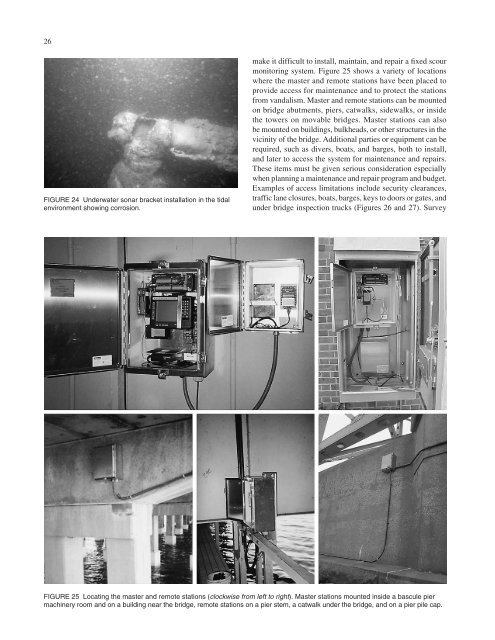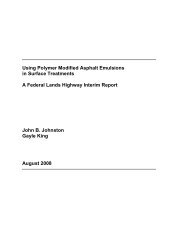NCHRP Synthesis 396 â Monitoring Scour Critical Bridges - TSP2
NCHRP Synthesis 396 â Monitoring Scour Critical Bridges - TSP2
NCHRP Synthesis 396 â Monitoring Scour Critical Bridges - TSP2
Create successful ePaper yourself
Turn your PDF publications into a flip-book with our unique Google optimized e-Paper software.
26<br />
FIGURE 24 Underwater sonar bracket installation in the tidal<br />
environment showing corrosion.<br />
make it difficult to install, maintain, and repair a fixed scour<br />
monitoring system. Figure 25 shows a variety of locations<br />
where the master and remote stations have been placed to<br />
provide access for maintenance and to protect the stations<br />
from vandalism. Master and remote stations can be mounted<br />
on bridge abutments, piers, catwalks, sidewalks, or inside<br />
the towers on movable bridges. Master stations can also<br />
be mounted on buildings, bulkheads, or other structures in the<br />
vicinity of the bridge. Additional parties or equipment can be<br />
required, such as divers, boats, and barges, both to install,<br />
and later to access the system for maintenance and repairs.<br />
These items must be given serious consideration especially<br />
when planning a maintenance and repair program and budget.<br />
Examples of access limitations include security clearances,<br />
traffic lane closures, boats, barges, keys to doors or gates, and<br />
under bridge inspection trucks (Figures 26 and 27). Survey<br />
FIGURE 25 Locating the master and remote stations (clockwise from left to right). Master stations mounted inside a bascule pier<br />
machinery room and on a building near the bridge, remote stations on a pier stem, a catwalk under the bridge, and on a pier pile cap.
















